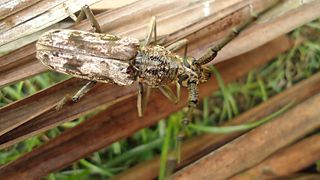
Blister beetles are beetles of the family Meloidae, so called for their defensive secretion of a blistering agent, cantharidin. About 7,500 species are known worldwide. Many are conspicuous and some are aposematically colored, announcing their toxicity to would-be predators.

The family Oedemeridae is a cosmopolitan group of beetles commonly known as false blister beetles, though some recent authors have coined the name pollen-feeding beetles. There are some 100 genera and 1,500 species in the family, mostly associated with rotting wood as larvae, though adults are quite common on flowers. The family was erected by Pierre André Latreille in 1810.

The cloven-feathered dove is a species of bird in the family Columbidae. It is monotypic within the genus Drepanoptila, but this genus is possibly better merged into Ptilinopus. The cloven-feathered dove is endemic to New Caledonia where found in forest and Melaleuca savanna at altitudes up to 1,000 m (3,300 ft).

The Pyrgotidae are an unusual family of flies (Diptera), one of only two families of Cyclorrhapha that lack ocelli. Most species are "picture-winged", as is typical among the Tephritoidea, but unlike other tephritoids, they are endoparasitoids; the females pursue scarab beetles in flight, laying an egg on the beetle's back under the elytra where the beetle cannot reach it. The egg hatches and the fly larva enters the body cavity of the beetle, feeding and eventually killing the host before pupating. In the United States, some species of Pyrgota and Sphecomyiella can be quite common in areas where their host beetles are abundant. Like their host beetles, these flies are primarily nocturnal, and are often attracted to artificial lights.

Acacia holosericea is a shrub native to tropical and inland northern Australia. It is commonly known as soapbush wattle, soapbush, strap wattle, candelabra wattle, silver wattle and silky wattle.

The Benito Juárez National Park is in the Valles Centrales Region of Oaxaca, Mexico, and includes parts of the municipalities of San Felipe Tejalapam and San Andres Huayapan. The southern boundary of the park is about 5 kilometers north of the City of Oaxaca. The park was established in 1937 during the presidency of General Lazaro Cardenas del Rio, and is named after President Benito Juárez, who was a native of Oaxaca.
Gymnostena holosericea is a species of beetle in the family Mordellidae, the only species in the genus Gymnostena.
Mordella holosericea is a species of beetle in the genus Mordella of the family Mordellidae, which is part of the superfamily Tenebrionoidea. It was discovered in 1851.

Pimeliinae is a subfamily of beetles in the family Tenebrionidae.

Gymnetis holosericea is a species of beetles of the family Scarabaeidae and subfamily Cetoniinae.

Gymnetis is a genus of beetles of the family Scarabaeidae and subfamily Cetoniinae.

Melaleuca holosericea is a plant in the myrtle family Myrtaceae which is endemic to the south-west of Western Australia. It is a small, rare shrub similar to other pink-flowered species in the Melaleuca scabra group.
Eryxia holosericea is a species of leaf beetle. It is distributed in the Democratic Republic of the Congo, Yemen, Mali, Senegal, Gabon, the Republic of the Congo and Ivory Coast. It was described by the German entomologist Johann Christoph Friedrich Klug in 1835.
Acalolepta holosericea is a species of beetle in the family Cerambycidae. It was described by Stephan von Breuning in 1939. It is known from India.
Senna holosericea is a perennial herb with yellow flowers that is native to the Arabian peninsula, Chad, Djibouti, Egypt, Eritrea, Ethiopia, India, Pakistan, Socotra, Somalia and Sudan.

Asidini is a tribe of darkling beetles in the subfamily Pimeliinae of the family Tenebrionidae. There are more than 30 genera in Asidini.
Eryxia is a genus of leaf beetles in the subfamily Eumolpinae. It is distributed in Africa and Western Asia.

Aeolesthes is a genus of beetles belonging to the family Cerambycidae.

Alphasida is a genus of beetles in the family Tenebrionidae.

Ophrys holosericea, the late spider orchid, is a species of flowering plant in the family Orchidaceae, native to western and central Europe and the Mediterranean region. There has been considerable confusion about the identity of this species and the correct spelling of its name.













